|
|
|
Sort Order |
|
|
|
Items / Page
|
|
|
|
|
|
|
| Srl | Item |
| 1 |
ID:
128513
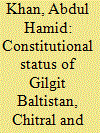

|
|
|
|
|
| Publication |
2013.
|
| Summary/Abstract |
Before the partition of the Indian sub-continent, the British handed over the tiny states including Yasin, Punial, Gupis, Ishkoman, Gilgit, Nagar, Hunza, Astore and Chilas to the Maharaja of Kashmir. Chilas was under the suzerainty of Yasin even after 1947. Before 1860, Mastuj (now part of Chitral), Gupis and Ishkoman were also integral parts of Yasin. After the murder of British spy Col. George Hayward by the Yasin ruler Mir Wali in 1873, differences between the State of Yasin and the British government had deepened. The British reacted by separating Mastuj, Koh Ghizer, Gupis and Ishkoman from Yasin. Rundu, Kharmang, Skardu, Ladakh and Astore remained under the direct control of Maharaja of Jammu and Kashmir. Before the partition of India, the Maharaja of Kashmir, on 1 August 1947, took over the administration of the entire Gilgit-Baltistan, i.e., former Gilgit Wazarat north of the Indus and all political districts. The area together with Bonji formed the Gilgit frontier province. Maharaja of Kashmir appointed Brigadier Ghansara Singh as the Governor, and also sanctioned the budget for the Gilgit frontier province.
|
|
|
|
|
|
|
|
|
|
|
|
|
|
|
|
| 2 |
ID:
128501
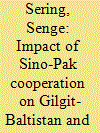

|
|
|
|
|
| Publication |
2013.
|
| Summary/Abstract |
The occupation of Gilgit-Baltistan by Pakistan and take-over of Xinjiang by China subsequently enabled both countries to build roads to consolidate their control over these regions. At the same time, opening of the Khunjerab Pass through the Karakoram Highway (KKH) allowed Pakistan and China to enhance commercial, military and political collaboration. However, the social, cultural and commercial interaction that today China and Pakistan has through the twin neighboring regions of Gilgit=Baltistan and Xinjiang
dates back several thousands of years. Since time immemorial, the mountain passes of the Karakoram Range facilitated traders and adventurers to travel through the valleys of Gilgit-Baltistan and Xinjiang and pursue their commercial and political interests in India, China and Central Asia. Then the shortest and safest among the passes, the Muztagh La, connected Braldo and Shaksgam valleys of Baltistan with important trading posts of Yarkand, Hotan, Kashgar, Badakhshan; admitting travel even farther north towards Beijing and Russia.' As part of the infamous Silk Route, Muztagh La pass facilitated "significant trade between Yarkand and the Braldo district of Baltistan"? At that time, Braldo was "central to the regional economy" and ranked high as the regional grain-basket? Many locals including those from the regional capital, Skardo, and the people of Hunza and N agar valleys made Braldo their home due to its strategic location on the famous trade artery. Social interaction enabled many Baltis to travel to Yarkand, Mazar and Khotan, and settle there.'
|
|
|
|
|
|
|
|
|
|
|
|
|
|
|
|
| 3 |
ID:
128510
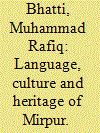

|
|
|
|
|
| Publication |
2013.
|
| Summary/Abstract |
Language, culture and heritage are the cornerstones of civilizations - ancient, medieval and present. It is very difficult to draw the lines of demarcation between languages, cultures and heritage of different regions
because these are interwoven and overlapping. Language is a medium of -expression of feelings, emotions, reason, prudence, passions and vision. Mankind since time irnmemorial has evolved different modes of expression, écalled tongues, dialects or languages. A language is a living organism, 'which originates, develops and dies. There are so many languages that have died away and are extinct now. l Culture re?ects the macro and micro behavioural structure of a society :generally accepted. All practices that people undertake, adopt or follow {consciously for their economic, social, political, moral, religious or spiritual
satisfaction come under the garb of culture. These practices, rites, rituals, =;customs, traditions, arts, architecture, food and dress etc. become part of . their individual and collective life and pass on from generation to -generation. It is a process of history and differentiates one community from other, one nation from other and one time span from the other. It is e a tree that has its roots in the past, branches in the present and shades future.
|
|
|
|
|
|
|
|
|
|
|
|
|
|
|
|
| 4 |
ID:
128505
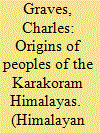

|
|
|
|
|
| Publication |
2013.
|
| Summary/Abstract |
The scholarly search for the origin of the people of this region often falls victim to the complex religious history of the area. If we leave aside the question of the religions of the people it may be possible to determine which 'peoples' at an early age inhabited the region up until recently called 'The Princely State of Jammu and Kashmir'. At 3,500 years ago (at 1,500 BPE - 'before the Present Era') the Indo- Aryans had already entered the Ganges plain and presumably there were some other elements of migrations from Central Asia which reached the more northerly areas of India called Kashmir. Moreover, it is possible some 'aboriginal' groups from Rajasthan and Gujarat had penetrated Kashmir as well as other parts of the sub-continent. Also some 'Dravidian' speakers (arriving in the sub-continent circa. 2,500 BPE) could have come to Kashmir.
|
|
|
|
|
|
|
|
|
|
|
|
|
|
|
|
| 5 |
ID:
128508
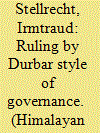

|
|
|
|
|
| Publication |
2013.
|
| Summary/Abstract |
In May 2009, in a small chat room in the Hunza Valley (in Northern Areas of Pakistan), a heated debate ?ared up over an old photograph. It showed Mir Muhammad Nazim Khan, ruler of Hunza State, from 1892
to 1938, and his Wazir, Humayun Beg, in ceremonial attire at the Imperial Coronation Durbar at Delhi in 1903. The opinions offered by the participants ranged from appreciation for great leaders of the past to their
utter condemnation as colonial 'devils' and exploiters. In fact, the photo conveys various messages. For me, first of all, it shows the integration of the Hunza Mir into a colonial hierarchy. Second, and more generally
speaking, it draws our attention to the world of durbars or 'ceremonial gatherings' in colonial India. Muhammad Nazim Khan was actively involved in this world.' He participated in two imperial durbars at Delhi, and every year he also attended a durbar, known as the Ialsa.
|
|
|
|
|
|
|
|
|
|
|
|
|
|
|
|
| 6 |
ID:
128516
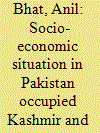

|
|
|
|
|
| Publication |
2013.
|
| Summary/Abstract |
in 1947 the combined population of Pak-occupied Kashmir (POK) and the 'Northern Areas" of Gilgit and Baltistan was 25 percent of the total population of ]&K State. Today this percentage has gone upto 33 percent of the total population of ]&K. The per decade growth rate of the population on both sides of the Line of Control (LoC) has remained the same. The steep rise in population in POK is because of the heavy in?ux of Punjabi Muslims from the plains. Today the Punjabi Muslims outnumber the Kashmiris in POK by a ratio of 5:1. Not only is 'Azad Kashmir' not Azad (free) - it hardly remains Kashmir except in name. Taking a cue from what the Chinese did in Tibet - the Pakistani Army has followed suit in POK - it has flooded the area with Punjabi Muslims to outnumber the Kashmiris in their own land. Most of the new Punjabi Muslim settlers were former soldiers of the Pakistani Army sent on a simple mission -
colonise Pakistan Occupied Kashmir, stamp out its Kashmiri identity all together, make it 'Pak' (which in Urdu means pure) by making it fully Punjabi. The grass always looks greener on the other side of the hill. It is a great tragedy that the strident propaganda of the jihadis has created a smoke screen that obfuscates the simple truth. Today we need to look across the LoC to see what is the reality. Not only is 'Azad Kashmir' no longer Kashmiri anymore in terms of demographic numbers, it never really was 'Azad' or free. In 1991, POK Prime Minister, Mumtaz Rathore was dismissed, arrested and flown by helicopter to a Pakistani prison.
|
|
|
|
|
|
|
|
|
|
|
|
|
|
|
|
|
|
|
|
|